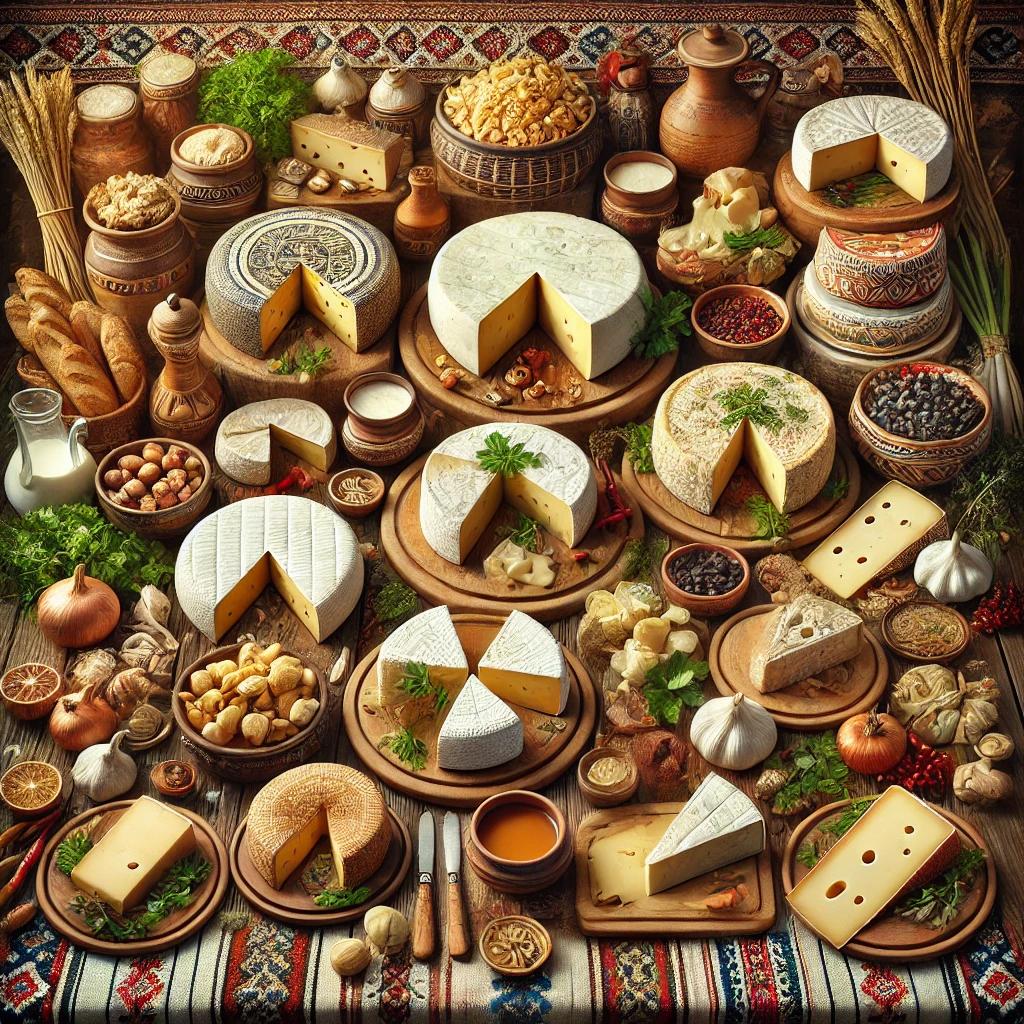Stretching across Romania, Ukraine, Slovakia, Poland, Hungary, and Czechia, the Carpathian Mountains form one of Europe’s most culturally layered dairy landscapes. Here, cheese is not only food—it is shepherd’s livelihood, mountain ritual, seasonal migration tradition, and a pastoral identity shaped by altitude, forest grasslands, and wooden huts where milk transforms into heritage.
From smoky sheep wheels to tangy brined blocks and buttery cow’s milk spreads, Carpathian cheese carries the aroma of pine forests, wild herbs, and open mountain pastures where sheep graze freely under shepherd watch.
This guide explores the rich cheese story of the Carpathians—its geography, craft, taste varieties, seasonality, and how centuries-old dairy methods continue to thrive in modern Europe.
🏔 Why the Carpathians Produce Exceptional Cheese
Mountain cheese in the Carpathians is defined by:
-
high-pasture grazing (transhumance)
-
herbal-mountain flora diet
-
raw milk processing
-
wooden smoke huts (smoke chambers)
-
sheep-dominant dairy culture
Sheep graze on:
-
wild thyme
-
alpine grass
-
sage
-
yellow flowers
-
pine-edged meadow herbs
This botanical diet results in natural aromatics and high milk fat, ideal for cheese complexity.
Key Features of Carpathian Cheeses
| Attribute | Influence |
|---|---|
| High altitude grazing | rich fat, herbal notes |
| Raw milk preference | stronger terroir identity |
| Smoking tradition | preservation + flavor |
| Seasonal production | spring-summer peak |
| Sheep dominance | tangy, nutty dairy profiles |
🧀 Major Cheese Varieties of the Carpathian Region
1. Bryndza (Brânză / Brynza)
Soft brined sheep cheese found in:
-
Slovakia
-
Poland
-
Romania
-
Ukraine
Flavor: tangy, sour-sweet, creamy
Use: dumplings (bryndzové halušky), spreads, soups
2. Oscypek (Poland)
Protected TSG smoked cheese from the Tatra mountains.
-
made from salted sheep curd
-
carved into decorated spindle shapes
-
smoked over spruce wood
Taste: smoky, firm, salty, buttery
3. Urda
Fresh whey cheese common in Romania & Moldova.
-
mild
-
light
-
slightly sweet
Often used in pastries, dumplings, and sweet fillings.
4. Korbáčiky (Slovakia)
Braided string cheese pulled by hand.
Texture: elastic
Flavor: lightly smoked or salted
5. Bundz / Budz (Poland & Ukraine)
Fresh sheep curd cheese:
-
spring specialty
-
mild, milky, slightly herbal
6. Telemea (Romanian Carpathians)
Semi-soft brined cheese, similar to feta but creamier.
-
sheep or cow milk
-
tangy, salty, crumbly
7. Năsal (Romania)
Unique cave-ripened cheese:
-
matured in natural Transylvanian cave
-
smooth paste, mushroom aroma
8. Vrkáč (Slovakia & Poland)
Soft, smoked cheese twist, often sold at mountain fairs.
🐑 Shepherding & Cheese Culture
Carpathian dairy is inseparable from transhumance—shepherds moving flocks seasonally.
Mountain Dairy Rituals
-
sheep shearing
-
wood-fired milk boiling
-
smoke curing
-
communal cheese sharing at huts (stână / koliba)
Shepherd huts remain dairy temples:
-
no refrigeration
-
pine wood curing
-
raw milk handling
-
smoke direct curing
Cheese is not factory-born—it is fire, wood, salt, sheep, and altitude.
🌲 Smoking Tradition: Signature of the Carpathians
Unlike Swiss alpine aging, the Carpathians favor smoke curing.
Woods Used:
-
spruce
-
beech
-
pine (moderate)
-
alder
Smoking benefits:
-
insect protection
-
longer shelf life
-
mountain transport durability
-
savory aroma depth
🍽 Culinary Uses Across Carpathian Tables
Popular Pairings
-
bryndza on dumplings
-
oscypek with cranberry sauce
-
urda in sweet pastries
-
telemea with tomatoes and olives
-
smoked cheese with rye bread
Carpathian Cheese Dishes
| Dish | Region | Cheese |
|---|---|---|
| Bryndzové halušky | Slovakia | bryndza |
| Kwaśnica soup | Poland | smoked cheese addition |
| Placinte | Moldova/Romania | urda or telemea |
| Shepherd’s spreads | Ukraine/Poland | bryndza & herbs |
| Mountain grilled cheese plates | Tatras | oscypek |
🌍 Flavor Profiles
| Cheese | Flavor | Texture |
|---|---|---|
| Bryndza | tangy, cultured | soft, spreadable |
| Oscypek | smoky, salty | firm, grillable |
| Urda | delicate, milky | fluffy, soft |
| Telemea | salty, bright | crumbly |
| Korbáčiky | mild, elastic | stringy |
| Bundz | fresh, grassy | semi-soft |
The region favors sharp tang + wood smoke + sheep richness.
🍷 Beverage Pairing Guide
Traditional
-
mountain herbal teas
-
homemade berry wines
-
sour cherry liquor (vișinată)
-
plum brandy (țuică / slivovitz)
Modern Pairings
| Drink | Cheese | Reason |
|---|---|---|
| dry Riesling | bryndza | acidity harmony |
| IPA beer | oscypek | bitterness vs smoke |
| Pinot Noir | telemea | light fruit vs salt |
| cider | urda | apple sweetness contrast |
🧊 Storage & Care
Most Carpathian cheeses are:
-
brined
-
smoked
-
semi-hard
Best Storage Practices
-
keep in brine when applicable
-
refrigerate smoked cheeses wrapped in cloth, not plastic
-
avoid freezing fresh urda (texture collapses)
Shelf Life
| Cheese | Timeline |
|---|---|
| Bryndza | 2–3 weeks refrigerated |
| Oscypek | 1–2 months smoked |
| Urda | 3–5 days |
| Telemea | up to 1 month in brine |
⭐ Final Summary
Carpathian cheese is alpine survival with soul: sheep milk turned into smoke-perfumed wheels, crumbly brined blocks, and spring meadow curds. Across Romania, Slovakia, Ukraine, Poland, and Hungary, cheesemaking is not industrial—it is mountain craft shaped by shepherding, wood, and seasonal pasture migration.
Whether tasting smoky oscypek by a mountain fire or creamy bryndza folded into dumplings, Carpathian cheese remains a portrait of rugged land, quiet huts, and dairy wisdom passed down in the highlands.
FAQs — Carpathian Region Cheese
1. What cheese is most iconic in the Carpathians?
Bryndza and oscypek represent the region’s pastoral and smoking heritage.
2. Are Carpathian cheeses mostly sheep-based?
Yes—sheep milk dominates due to mountain grazing suitability.
3. Why is smoking common in the region?
Smoke preserves cheese for travel, altitude winters, and shepherd huts.
4. What makes Carpathian cheese unique?
Raw milk, high-altitude herbs, wooden smoke curing, and pastoral handling.
5. Can Carpathian cheese be grilled?
Oscypek and some smoked varieties grill beautifully without melting away.



